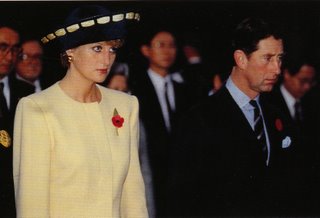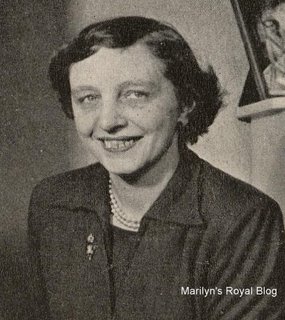Most people may get their royalty news from tabloids, legitimate media or unofficial royal sites, but one of the best sources for information are the official sites. The details may not be juicy but they're a fantastic resource. Nearly all royal families realize the value of having a website for announcements, and general information. Over time, some of the sites have added multi-media features such as virtual tours, music, audio and occassional videos. Although there are many official sites out there, I've decided to review just a few of them. Note, links to these sites are available on the sidebar to the left.
The Official Site of the British Monarchy. One of the best sites out there, comprehensive, it can answer almost any question that you have regarding the family, its traditions, and ceremonies. It has a monthly on-line news magazine, with some of the questions rumoured to be answered by the Duke of York himself. Not to mention access to the Royal Collection with an impressive e-gallery. Has a children's section. Updated frequently it is always up to the minute in terms of the information offered.
The Greek Royal family Site: Greek and English. This site seems to be under construction and some of the information is disappointing. An improvement from its previous incarnation, but it still has a ways to go. For one there is a complete lack of history of the Greek royal family and the site seems to be more of a press release for ex-King Constantine regarding his legal issues.
The Danish Monarchy: English and Danish. Clean and stylish, this site is proof that you don't need multi-media to make a site interesting.The bio's are very informative, but it has limited information regarding the activities of the family. It would be nice if there was more information on previous Danish sovereigns other than a chronological list. Also, some of the information has yet to be updated, such as the bios of the Crown Prince and Princess, which say nothing about the birth of their son Prince Christian.
The Official Site of the Prince's Palace of Monaco: English and French. At one point this site was practically non-existent in terms of information about the current royal family. It has since been redesigned, however it doesn't seem to have much history regarding the Grimaldi family. Information for the Sovereign Prince reads like a resume but otherwise the bio's for the current family are fairly comprehensive. Although the site is bilingual, if you select press releases they will come up in French. I'm not certain whether this is a glitch or not but I've found this frustrating on more than one occassion.
The Dutch Royal House: English and Dutch. This site has been redesigned so it's much easier to use and navigate. One of the few sites to have a children's section, which includes some charming letters and drawings. A photo section allows downloading for personal use. Some of the photos are very casual, a welcome departure from some of the more formal poses released by other royal families. Unlike other royal sites, reading the biographies in the 'Who's Who" section, and especially seeing the photos, one gets a sense of family as opposed to a Royal House. Public engagements, news, photos of current activities and important announcements are only available on the Dutch version of this site. If an important event occurs, such as the birth of the Crown Prince and Princess's younger daughter, the visitor is left to decipher the announcement. Offers 'virtual tours' of the palaces, but some of the tours are slow to load. The history section is not nearly as comprehensive as the British site.
The Belgian Monarchy: English, Dutch, French and German. The only sections that are not available in English are the recent royal births, engagements and archives of individual members. Informative and easy to navigate, the site has some nice sections, the birth Princess Elisabeth is a sweet example, with video of the newborn Princess with her parents.
The Royal House of Norway: Norwegian and English. Some nice biographies of the members of the royal house. A more detailed history of previous monarchs would be nice. Some of the announcements are rather limited and brief, and I've found that some important updates are not in English. Photos are available in the Norwegian section of the site. Has a family tree, showing the relationship between the royal houses of Britain, Sweden, Norway and Denmark. if you click on various people will come up with short biographies of the person. In comparison to some of the other royal sites, this appears a bit basic. I could not locate a site map or any contact information in English.
The Swedish Royal Court: Swedish and English. This site has also been recent redesigned and it's much easier to navigate. Second only to the British site in terms of being comprehensive, it has the option to listen to the site. Unlike the Monagasque site, the language feature is consistent - if you select English, the entire site appears in English. In reviewing, I found a discrepancy in Princess Victoria's birthdate and when I contacted the webmaster I was given an unexpected personalized response.
The Imperial Household Agency Homepage (Japanese Royalty): Japanese and English. Overall I think this is one of the worst sites, aesthetically outdated and difficult to navigate. Has a wealth of information but it's not presented in a very impressive fashion. Unlike other sites, it has some interviews with members of the royal family. Awkwardly laid out, some of the characters in the personal histories don't translate properly. Contact information is limited to an email address.
The Royal Household of His Majesty the King (The Royal House of Spain): Spanish and English. Recently redesigned but still being worked on. It's an improvement on its previous incarnation, which you can see if you click on the link to it. Despite selecting English, some of the sections still come up in Spanish. I didn't find this site particularly easy to navigate. If there is a history of the monarchy I couldn't find it. Has information on the various palaces, including virtual tours.
King Abdullah II of Jordan's website: Arabic and English. One of the few sites to have music! For some reason the King and Queen have separate websites. The Queen's site is actually wonderful, focusing on her initiatives with women and empowerment. Great information about the couple's separate initiatives.
The Princely House of Liechtenstein: German and English. Although I'm not particularly familar with this royalty, should I want to learn more the information is here in this rather sparse site. Has information each reigning Prince since 1608, the history of the Princely House, the Constitution, Titles, Orders and Decorations, and a link to the Princely Collection. Very limited information about the current family aside from names and dates of birth. Also has a link to the LGT group, which provides financial services to the royal family, as well as anyone else who might be interested, which I think is a bit unusual.
Serbian Royalty: Style wise I found this site to be inconsistent and a bit busy, particularly the history page. On the front page, if you mouse over the members of the family it will highlight the person and fade the other members. Has movies , radio interviews, and information about the history, flags, and a nice page about the Royal Palaces.
© Marilyn Braun 2006
 It's a boy!!!!!
It's a boy!!!!!



























